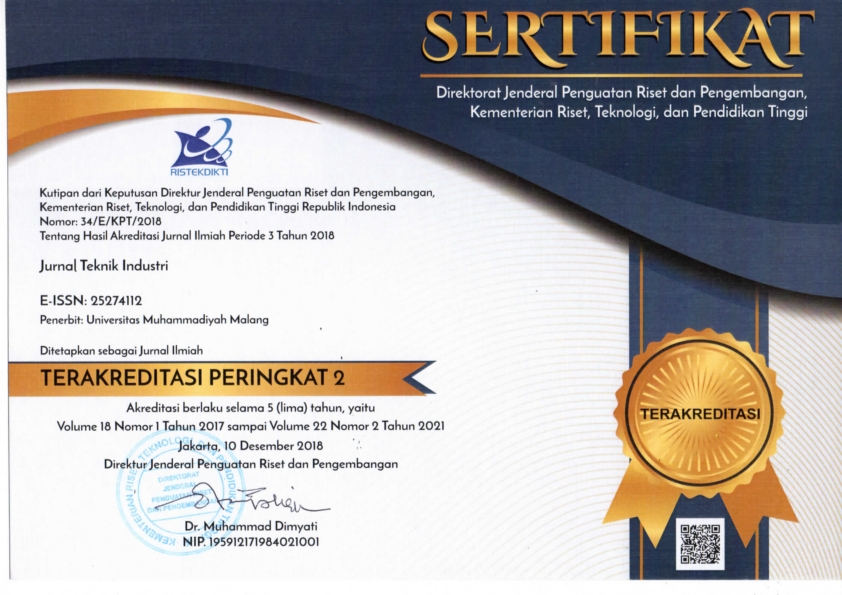Lean Production: A Way To Reduce The Internal Inventory And Cycle Time
DOI:
https://doi.org/10.22219/JTIUMM.Vol8.No2.99-107Keywords:
lean production, wastes, flow shop, job shop, inventoryAbstract
The progressive competition among industries and the increase of customer expectation will lead the progressive efforts in reducing the cost of production and logistic activities in the future. The companies (mass production, job shop and service industries) are forced to tighten their production process effectively by cutting the unnecessary activities in logistic flow, delete dummy and redundant elements, specializing the core business, and eliminate the wastes to simple and make their production process is more competitive. The lean concept could be the alternative way to reduce the main wastes: inventories and production cycle time. Eventhough it is very expensive to implement the lean production in the shop floor production, but the waste elimination and continuous improvement as the main key of the lean thinking has promised a significant improvement and profit for companies which implement the concept. The tools that could be used as methods to make the production process leaner such as just in time with kanban card system, kitting principle, collaborative scheduling and production plan, group technology, cell manufacture design and line balancing are well implemented in the worldwide. The efforts in leaning production will continue due to the lean thinking basically try to make the system better and believe that there is no best system but there is always better system.
Downloads
References
Abdi, F., Shavarini, K., S., Hoseini, M., S., 2006. Glean Lean: How to use lean approach in service industries? Journal of Service Research 6 (special issue). Retrieved September 30, 2007, from Proquest.
Arnold, JR and Chapman NS., 1991. Introduction to material management, Prentice-Hall,New Jersey.
Ballau, HR 1987, Basic business logistic: transportation material management, phisycal distribution, 2nd edn, Prentice Hall, New Jersey.
Brockhurst, B., 2006. Lean Manufacturing for job shop. Woodworking Journal 20(6). Retrieved August 17, 2007, from Proquest.
Burt, D.N. 1984. Proactive Procurement: The Key to Increased Profit, Productivity and Quality. Prentice Hall. New jersey.
Burt, D., Dobler, D. and Starling S., 2003, World Class Supply Management: The Key to Supply Chain Management with Student CD (Cases), 7th Edition.
McGrawHill
Brandt, D., 2007. The House that Lean saved. Industrial engineer. Retrieved August 17, 2007, from Proquest.
Chen, W., J., 2006. Minimizing Total flow time in the single-machine scheduling problem with periodic maintenance. Journal of the Oprational Research Society 54 (410). Retrieved August 17, 2007, from Proquest.
Haftl, L., 2007. How best Shops reduce cycle time, American Machinist Journal. Retrieved August 17, 2007, from Proquest.
Hancock M, W, Zayko, J,M. 1998. Lean production Implication. IIE Solution. Retrieved August 17, 2007, from Proquest.
Hunter, L.,S., 2003. An introduction to lean production systems. FDM.Journal 75 (13). Retrieved August 17, 2007, from Proquest: http://proquest.umi.com. dbgw.lis.curtin.edu.au/pqdweb?did=446042251&s id=9&Fmt=4&clientId=22212&RQT=309&VNa me=PQD
Hunter, L., S., 2003. Lean manufacturing: designing the cells, FDM Journal 175(14), Retrieved August 17, 2007, from Proquest.
Jiang C., J., and Chen, K., 2007. Development of Collaborative Manufacturing, Planning, and Scheduling System: Integrating Lean and Agile Manufacturing for Supply Chain. International Journal of Management 24 (2). Retrieved August 17, 2007, from Proquest.
Jones, T., D., Roos, D., and Womack, P.,J., 2007. The Machine That Changed the World: The Story of Lean Production. Simon & Schuster.
Koenigsaecker, G, 2006, Stategy Development: Linking Lean to Business strategy, Manufacturing engineering.
Retrieved August 17, 2007, from Proquest. Malloy, J., 2004. Retrieved August 17, 2007 from http://
searchcio.techtarget.com/sDefinition/0,,sid19_ gci810519,00.html
Ness, M., 2007. A Foundation for continous improvement,
Circuit Assembly Journal 8(18). Retrieved August 17, 2007, from Proquest.
Parker, Mike, Slaughter, Jane. 1994. Lean production is mean production: TQM equals management by stress, Journal of Canadian Dimension 28(1). Retrieved August 17, 2007, from Proquest:
Shields, T., 1999. What Is "Lean". Massachusetts Institute of Technology Retrieved August 17, 2007, from http://www.dau.mil/educdept/ mm_dept_resources/ navbar/lean/01rdg-lean.asp
Suzuki, Y., 2004. Structure of the Japanese production system: elusiveness and reality. Asian Business and Management Journal Vol. 3 pg. 201. Retrieved August 17, 2007, from Proquest.











